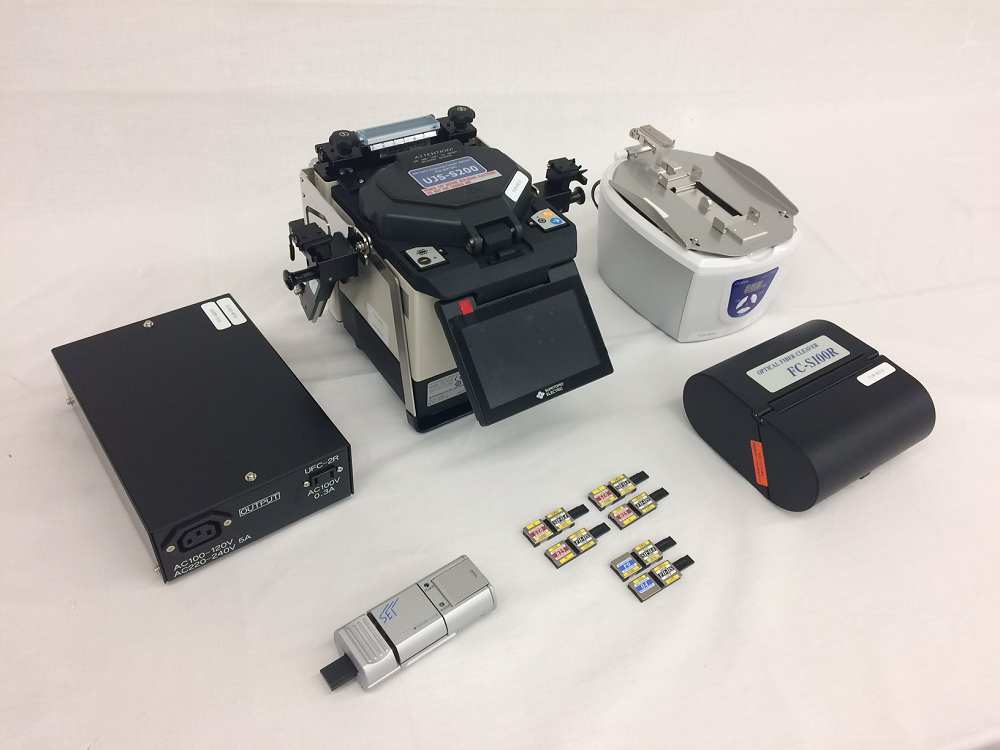General
This fusion splicer automatically aligns a pair of optical fibers in both the X and Y (horizontal and vertical) planes and then fuses them together with heat from an electric arc to form a low-loss splice. Improved image processing software of this fusion splicer enables precise core alignment and accurately estimated splice loss.
A tensile proof test that is carried out by applying tension to the fusion splice verifies the long-term reliability of the fiber splice. Following a successful proof test, a heat-shrinkable splice protection sleeve is installed over the bare glass fiber and cured in the built-in heater.
Applicability of Numerous Fiber Splicing Conditions
Since the beginning of optical submarine cable installation, a wide range of optical fibers have been qualified with Universal Jointing and in each case, the specific fiber splicing conditions have been provided for repairing and installation of the Universal Joints and the Universal Couplings. As supplied, the fusion splicer UJS-S200 is pre-loaded with over 430 fiber splicing conditions, so it is ready to splice the fibers deployed in the optical submarine cables.
Long Term Reliability with Low Failure Probability of Fiber Splice Point
Conventionally long term reliability with low failure probability requires a high rate of fiber splice proof testing. By utilizing the specific fiber handling mechanism, and with providing 3mm of fiber cleave length, the fusion splicer UJS-S200 minimizes the strains such as twist, bend and tension to the fiber splice with a relatively lower proof test level. By incorporating this advanced technology, a low failure probability of 1x10-6 % for the fiber splice can be achieved for 25 years of submarine cable service life.
UJ Consortium Member Jointer Training Schools
Alcatel Submarine Networks (ASN) Jointer Training School
Calais, France
Global Marine Jointer Training School
Chelmsford, Essex, United Kingdom
KDDI Cableships & Subsea Engineering Inc. (KCS) Jointer Training School
Yokohama, Kanagawa, Japan
SubCom Jointer Training School
Baltimore, Maryland, USA.
Full contact details of all UJ Consortium Training Schools are provided on the UJC Training Schools Contacts page.
UJ Consortium Sponsored Jointer Training Schools
The provision of consistent, high quality jointer training is essential for the successful transfer of Universal Jointing technology from the designers into the field. The following non-UJC member training schools’ facilities and instructors are sponsored by a UJC member and are Sponsored as providing ‘UJC sponsored’ jointer training and certification, ensuring that high quality training is given and that full traceability can be maintained.
Limitations: UJC Sponsored Training Schools may train only their own jointing personnel in Universal Jointing (UJ/UC and UQJ) technologies and must only use the staff trained by the UJC certified instructors for this purpose. UJC Sponsored Training School instructors cannot in turn train or certify other instructors.
SB Submarine Systems sponsored by Global Marine.
Wujing, Shanghai, PR China
LS Marine Solution Co. Ltd. sponsored by Global Marine.
887, Geojebuk-ro, Yeoncho-myeon, Geoje-si, Gyeongsangnam-do, 53204, Korea
 |
Alcatel Submarine Networks |
 |
Global Marine |
 |
Kokusai Cable Ship Company Limited |
 |
SubCom |
Design and Specification
Universal Jointing equipment is designed for functionality, accuracy, portability and reliability, thus giving consistent, optimum results in the harsh shipboard marine environment. Designs and manufacturing methods are frequently reviewed to optimise performance and, where appropriate, to minimise jointing times.
The UJ Consortium strongly recommends the use of only the jointing equipment items specified in the UJ and UQJ Construction Manuals. Details of jointing equipment items common to all UJs and UCs are provided on the Jointing Equipment Page of the UJ Consortium website.
Inspection, Qualification and Calibration
The quality management systems of all of the UJ Consortium suppliers are accredited against the relevant standards (i.e. ISO 9001) and they apply rigorous measures to ensure that the Universal Jointing equipment they supply is inspected, tested and, where appropriate, calibrated against traceable standards. Manufacturers of assured quality are utilized for equipment manufacture, working from UJ Consortium approved and controlled drawings, using certified materials and inspected using measuring equipment that is calibrated against traceable standards.
Maintenance and Re-calibration
Universal Jointing equipment is supplied with an Operation and Maintenance Manual (OMM). Current issues of the Operation and Maintenance Manuals are provided on the UJ Explorer data stick. The UJ Consortium strongly recommends equipment users to have suitably qualified technicians maintain the equipment by reference to the appropriate manual and to operate a regular re-calibration program where this is specified in the Operation and Maintenance Manual.
Purchase of Jointing Equipment
UJ, UC and UQJ jointing equipment can be purchased from any Consortium Member. Contact details of each of the UJ Consortium Members can be found on the Contacts Page of this website.


